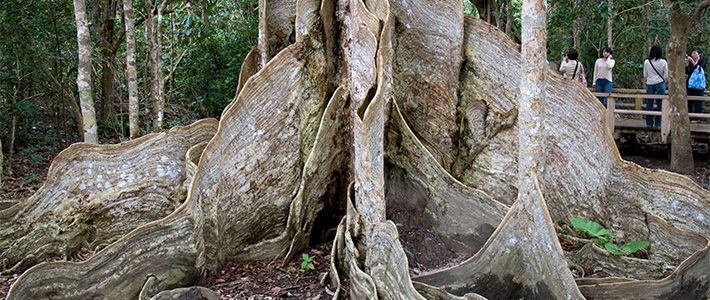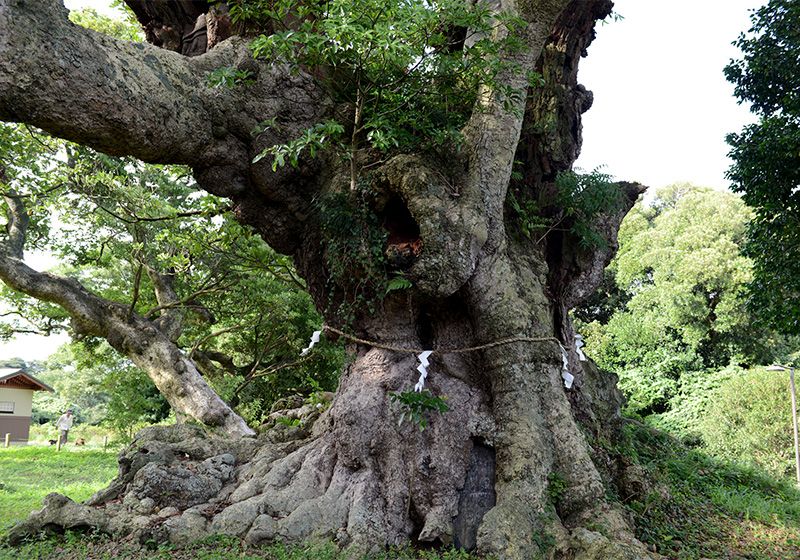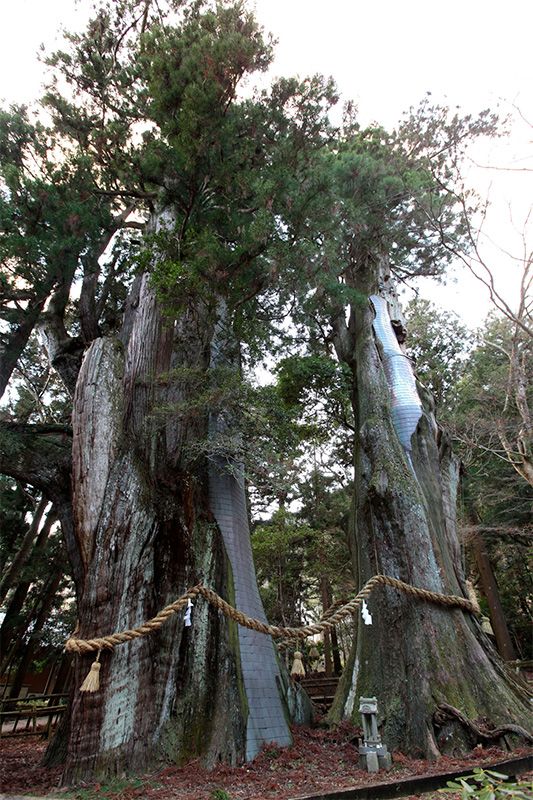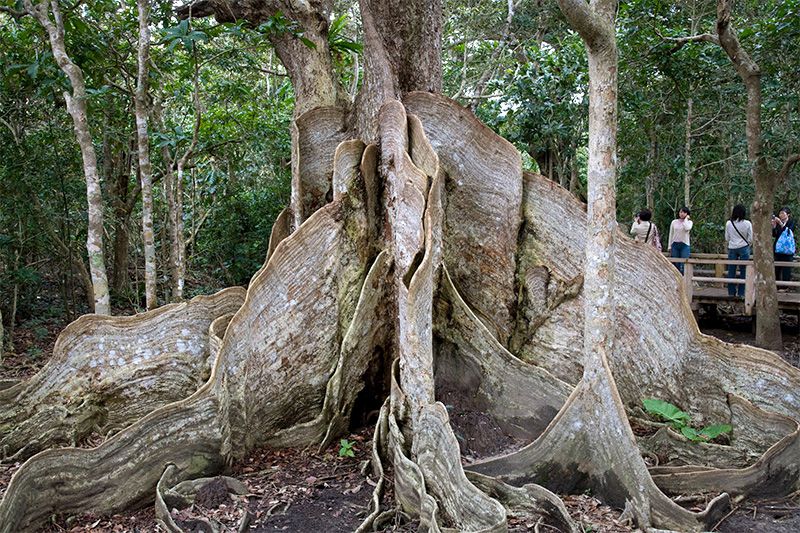
Japan’s Ancient Giants of the Forest
Wind and Rain: Three Ancient Trees in Typhoon Season
Guideto Japan
Culture- English
- 日本語
- 简体字
- 繁體字
- Français
- Español
- العربية
- Русский
Typhoons and Trees
Autumn is a pivotal time for trees as they rejuvenate following the sweltering summer months and prepare for the looming cold of winter. But fall is also the season of typhoons. The storms present a serious threat to older, weaker trees, particularly those along the Pacific coast of western Japan where the tempests frequently come ashore. Kyoju, or old-growth trees, have size on their side, although even these venerable giants can come toppling down in the face of relentless wind and rain.
Camphor and other species boasting burly limbs and hearty root systems account for many of the oldest trees in typhoon-prone areas. Specimens tend to be shorter than their compatriots in less blustery regions, presumably due to losing limbs in past storms. However, what they lack in height they more than make up for in sheer girth, a necessary trait for surviving any future squalls. Below we visit three of these stout woodland giants during typhoon season.
The Great Bay of Fuma (Chiba Prefecture)
Variety: Tabunoki (Japanese bay tree) (Machilus thunbergii)
Location: Uga Shrine, 2395 Fuma, Katori, Chiba Prefecture, 289-0411
Trunk circumference: 8.9 m; height: 16 m; age: 1,500 years (according to legend)
Designated a national natural monument
Size: ★★★
Vigor: ★★
Shape: ★★
Crown spread: ★★
Grandeur: ★★★★
This titan stands on the grounds of the Uga Shrine within the sprawling ruins of Fuma Castle in Chiba Prefecture. Located on a hill, the tree commands a stunning view of the surrounding fields and forests. The raised topography once served as a natural barricade for the stronghold that in the past housed nine leaders of the famed Chiba warlord clan.
The grand bay was designated a national natural monument in 1926. But in a case of mistaken identity, it was at first registered as a camphor, a closely related species, instead of a Japanese bay tree. This error was later rectified, although the camphor label has persisted.
The environment around the knotty specimen has changed considerably in the years since I first visited. The tree has become a tourist attraction for Katori, and land adjacent to it has been turned into a public park. In October 2013, a portion of the trunk broke off during a violent typhoon that battered the southern Kantō region. Fortunately, damage to the root system that would have potentially wilted the plant was averted, although the storm irreparably marred the tree’s shape.
Despite this incident, the kyoju is still impressive to behold. (In an unexpected twist, though, the loss of the branches has brightened the grounds of the shrine, which were previously rather dark and uninviting.) Visitors can also see a fascinating example of the reproductive cycle of Japanese bays. A few meters from the tree an offshoot juts at an angle from the ground. The tilted specimen was once a branch that grew out and eventually put down roots of its own.
The Grand Cedar of Yasaka Shrine (Kōchi Prefecture)
Variety: Sugi (Japanese cedar) (Cryptomeria japonica)
Location: Yasaka Shrine, Sugi, Ōtoyo, Nagaoka, Kōchi Prefecture, 789-0311
Trunk circumference: 15.6 m; height: 52 m; age: 3,000 years
Designated a special natural monument
Size: ★★★★★
Vigor: ★★★
Shape: ★★★★
Crown spread: ★★
Grandeur: ★★★★★
There is an ongoing debate among old-growth tree lovers over Japan’s largest Japanese cedar. Most people will point to the Jōmon Sugi on Yakushima as the obvious choice. However, the tree was only discovered in 1966, which implies that a different kyoju held the title previously. A little digging through historical documents pointed me in the direction of the grand cedar of Yasaka Shrine in Kōchi Prefecture, one of only two sugi designated as special natural monuments.
The tree has a distinct form. It boasts dual trunks, one to the south and one to the north, but these extend from a single root system and are considered a single specimen. The minami, or south, bole is the more robust of the two and is thought to have gained its girth by enveloping a smaller cedar sometime in the past. Its circumference is matched by its height, which the Agency for Cultural Affairs at one time listed as an astounding 68 meters.
This figure turned out to be slightly exaggerated, though. A 2001 survey found the cedar to be 57 meters tall, while another in 2016 that used a laser measuring device determined the height to be 52 meters. This discrepancy can potentially be chalked up to typhoon damage that has withered the upper reaches of the giant, shortening it by a few meters. Nonetheless, the grand specimen is worthy of admiration for growing as tall as it has in such a storm-prone area of Japan.
The Nakama River Looking-Glass Mangrove (Okinawa Prefecture)
Variety: Sakishima suōnoki (looking-glass mangrove) (Heritiera littoralis)
Location: Haimi, Taketomi, Yaeyama, Okinawa Prefecture, 907-1434
Trunk circumference: 35.1 m; height: 18 m; age: 400 years
Size: ★★★★★
Vigor: ★★★★
Shape: ★★★★★
Crown spread: ★★★
Grandeur: ★★★★
This famous old tree was first discovered in 1982. Located near the Nakama River on Iriomotejima in Okinawa Prefecture, it is thought to be Japan’s largest specimen of looking-glass mangrove, a species that grows in latitudes south of Amami Ōshima. It is one of the island’s two most recognized tourist attractions, the other being water buffalo-drawn carts, and lures around 300,000 visitors annually.
The ribbon-like roots of the tree are its most impressive trait. There are 10 snaking from the trunk, the tallest being 3.1 meters high. The appendages give the tree a splendid girth comparable to Japan’s largest kyoju, the grand camphor of Kamō. Pictures do not do these winding natural wonders justice, though, and their artistic curves are best admired in person.
The roots of looking-glass mangroves are not only beautiful, but also incredibly strong. In the past they were used by islanders in boatmaking. This strength has sustained the ancient Nakama River specimen through the frequent typhoons that batter Iriomotejima and surrounding islands. Gazing at the mighty tree, it is easy to imagine its slowly taking its distinctive sturdy form by weathering successive storms over the centuries. I am also reminded with each new typhoon season that this process is still underway.
(Originally published in Japanese on September 22, 2016. Photos and text by Takahashi Hiroshi.)

